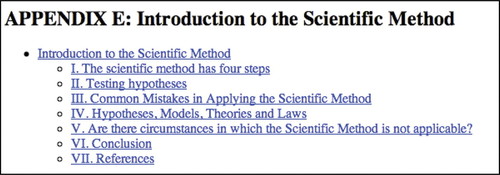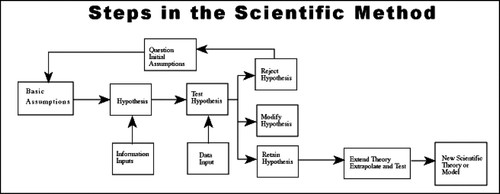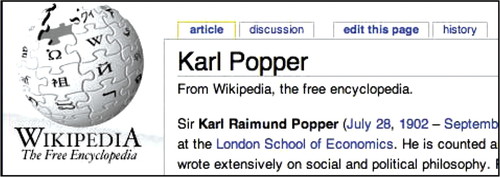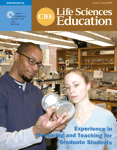WWW: The Scientific Method
INTRODUCTION
Each quarter, CBE—Life Sciences Education calls attention to several Web sites of educational interest to the life science community. The journal does not endorse or guarantee the accuracy of the information at any of the listed sites. If you want to comment on the selections or suggest future inclusions, please send a message to [email protected]. The sites listed below were last accessed on 1 December 2005.
The topic selection of the scientific method for this quarter's column was prompted in part by the recent revision of the K–12 science education standards by the Kansas State Board of Education on November 8, 2005 (Figure 1). http://www.ksbe.state.ks.us/Welcome.html
Figure 1. Kansas State Board of Education.
Many have interpreted the November actions of the Kansas State Board of Education as allowing the teaching of “intelligent design” as an alternative to biological evolution. One may download the science standards advocated by the Board from the aforementioned Web site. A portion of their rationale for change is presented below.
Regarding the scientific theory of biological evolution, the curriculum standards call for students to learn about the best evidence for modern evolutionary theory, but also to learn about areas where scientists are raising scientific criticisms of the theory. These curriculum standards reflect the Board's objective of: 1) to help students understand the full range of scientific views that exist on this topic, 2) to enhance critical thinking and the understanding of the scientific method by encouraging students to study different and opposing scientific evidence, and 3) to ensure that science education in our state is `secular, neutral, and nonideological.'
As the debate about the actions of the Kansas State Board of Education continues, the role of the scientific method in the process of science requires clarification for many.
The scientific method is the principal methodology by which biological knowledge is gained and disseminated. As fundamental as the scientific method may be, its historical development is poorly understood, its definition is variable, and its deployment is uneven. Scientific progress may occur without the strictures imposed by the formal application of the scientific method. This report explores Web resources that get at the definition, history, and use of the scientific method.
A good place to begin this odyssey is with the organization known as Science Service. Science Service, a Washington, DC-based nonprofit organization, is best known as the publisher of Science News and as the organizer of the International Science and Engineering Fair. In its promotion of high school science, Science Service provides a Web page describing the scientific method (Figure 2). http://www.sciserv.org/isef/primer/scientific_method.asp
Figure 2. Science Service.
One may find a carefully worded description of the scientific method consisting of the following steps: problem/purpose, hypothesis, procedure, materials, observation/data/results, analysis, and conclusion. Most would agree that this recounting of the scientific method would be appropriate for a budding young scientist, especially one who is preparing a science fair project.
Another organization that promotes science education for the K–12 audience is eMINTS (enhancing Missouri's Instructional Networked Teaching Strategies; Figure 3). http://www.emints.org/about/index.shtml#educators
Figure 3. eMINTS.
This organization developed by three Missouri agencies (University of Missouri, the Missouri Department of Elementary and Secondary Education, and the Missouri Department of Higher Education) advocates the following:“ eMINTs changes how teachers teach and students learn. Its instructional model provides a research-based approach to organizing instruction and can be implemented in any subject area at any level.” eMINTS provides a page dealing with the scientific method. http://www.emints.org/ethemes/resources/S00000408.shtml
This eMINTS Scientific Method Web page offers links to very high-quality and traditional material that includes activities such as “Does Soap Float?” and the Scientific Method scramble. One of the links available is to the Discovery School maintained by Discovery Communications (Figure 4). http://school.discovery.com/sciencefaircentral/scifairstudio/handbook/scientificmethod.html
Figure 4. Science Fair Central.
Science Fair Central provides a five-step explanation for the scientific method: research, problem, hypothesis, project experimentation, and project conclusion. The material is derived from Janice VanCleave's Guide to the Best Science Fair Projects, a John Wiley & Sons (New York) publication.
Each of the three Web sites listed above provides a traditional and generally accepted view of the scientific method, as it would be found in support of classroom activities. Most people agree that to understand science, one must do science. The argument continues that to do science, one must use the scientific method as though it were a form of catechism with heavy emphasis on the steps used by the scientific method. For an example of placing emphasis on the steps to the method, please visit the following Web site (Figure 5): http://teacher.nsrl.rochester.edu/phy_labs/AppendixE/AppendixE.html
Figure 5. Frank Wolfs' introduction to the scientific method.
Dr. Frank Wolfs in the Department of Physics and Astronomy at the University of Rochester (Rochester, NY) provides a scientific method appendix to the laboratory manuals associated with the introductory college physics courses at Rochester. He, as do many of his science colleagues, states that the scientific method has four steps: 1) observation and description of a phenomenon or group of phenomena; 2) formulation of a hypothesis to explain the phenomena (in physics, the hypothesis often takes the form of a causal mechanism or a mathematical relation); 3) use of the hypothesis to predict the existence of other phenomena or to predict quantitatively the results of new observations; and 4) performance of experimental tests of the predictions by several independent experimenters and properly performed experiments.
The laboratory manual for my embryology or histology course could have a similar type of statement. As we lead our students into the forest of doing science, we codify the process as requiring prescribed steps, and, like bread crumbs, these steps are to be followed through the forest. This teaching practice causes people to view science as formulaic and perhaps less of a creative process than it really is. This tendency to make the process pedantic is exemplified by the information at the following Web site (Figure 6): http://www.ldolphin.org/SciMeth2.html
Figure 6. Lambert Dolphin's steps in the scientific method.
Lambert Dolphin of Palo Alto, CA, lays out the scientific method in a flowchart manner. Dolphin also mixes this depiction of scientific methodology with a discussion of personal philosophy and religion.
Another example of the scientific method being incorporated into a personal philosophy is associated with the following Web site (Figure 7). http://www.scientificmethod.com/index.html
Figure 7. Norman W. Edmund's idea of the scientific method.
Norman W. Edmund is the founder of the well-known Edmund Scientific (Tonawanda, NY), a mail-order company for science supplies. His company has been sold and incorporated into a new company called Scientifics. Edmund considers the scientific method “the greatest idea of all times.” He defines the scientific method as follows: “The term `the scientific method' represents the general pattern of the types of mental activity stages (usually aided by physical activities) that occur in the master method, which we use to obtain, refine, extend and apply knowledge in all fields.”
The Science Service and eMINTS' use of the term scientific method would be generally accepted in science education fields. Dolphin and Edmund's use would be problematic for many. And in common practice as represented by the physics laboratory manuals, the scientific method is presented as a rigid process that is followed as though it were a religious doctrine. These practices lead us back to the Kansas Board of Education: “secular, neutral, and nonideological.” At this juncture, it is time to visit Charles Darwin.
Dr. Ian C. Johnston of the Department of Liberal Studies at Malaspina University-College (Nanaimo, British Columbia, Canada) has prepared a handbook for liberal arts students exploring the history of science. He gives his interpretations into the origins of evolutionary theory and in doing so provides insights into the scientific method (Figure 8). http://www.mala.bc.ca/%7Ejohnstoi/darwin/sect3.htm
Figure 8. Ian C. Johnston's interpretations of the origins of evolutionary theory.
Darwin's delay in publishing his theory involved factors other than the stormy political climate. For what he was proposing marked a significant departure from conventional English empirical science. At the heart of natural philosophy in England, as we have seen earlier, was an emphasis on observation and experiment. Even though most scientists did not follow precisely the Baconian emphasis on the primary role of empirical observation, nevertheless, they recognized the crucial importance of experimental testing of particular hypotheses.
This requirement presented Darwin with a grave methodological problem, simply because he was proposing a theory in which direct observation and experiment were clearly impossible, at least in the sense that a biologist could confirm the hypothesis of natural selection by observing it in the action of significantly transforming one species into another. Obviously, the time spans involved and the often minute succession of variations by which one species developed out of a species with quite a different appearance (e.g., reptiles from fish) meant that no direct testing by observation and experiment was possible.
To meet this difficulty, Darwin developed a new scientific procedure, now known as the hypothetico-deductive method. He first developed a theory, relying upon analogy and deduction to organize a plausible explanation, without direct empirical evidence, and then applied that theory to a wide range of facts, to demonstrate the explanatory power of what he was proposing.
Johnston reminds us that the scientific method has evolved over a period of time and that the lengthy gap between Darwin's Beagle trip and the publication of the Origin of Species had to do with the limitations in the methodology of doing science at that time. Finding both irony and humor in Darwin contributing to the evolution of the scientific method, we turned to Google ( htpp://www.google.com) to search for a history of the scientific method.
Michael James has provided an interesting essay on the history of the scientific method; the essay is a frequent hit on many search engines (Figure 9). http://www.scientificmethod.co.uk/
Figure 9. Michael James' essay on the history of the scientific method.
James is a graduate student in the human geography department at the Open University in England. He concludes his essay with the following thought:“ For every individual, science acquires systematic knowledge of the truth and laws of natural or physical phenomena that govern the world. Science classifies by definite rules. To be `scientific' is to agree with, and be well instructed in the principles of science. The manner of proceeding to an end, by orderly means, is `method'. The appearance that the use of scientific method is simply logical can be misleading, there is no more complex question of how we arrive at our thoughts.” It seems James would argue that the flow chart showing the scientific method does not cover the thinking involved in the process.
The now ubiquitous Wikipedia, the Internet encyclopedia, provides a number of portals into the history of the scientific method (Figure 10). http://en.wikipedia.org/wiki/Scientific_method http://en.wikipedia.org/wiki/Baconian_method http://en.wikipedia.org/wiki/Hypothetico-deductive_method
Figure 10. Wikipedia's entry on Karl Popper.
Francis Bacon, a contemporary of Shakespeare, developed a method of scientific reasoning and investigation that was widely adhered to for several centuries. Johnston (above) alludes to Darwin having to deal with the Baconian method. Karl Popper developed the hypothetico-deductive method in the twentieth century and its practice involves falsification of the hypothesis. It is the falsification idea that contributes greatly to today's misunderstanding of what science is, and how the modern version of the scientific method is used. The issue of falsification is also where the Kansas Board of Education enters Dante's Divine Comedy and descends into the inferno. The Board's objective one is “to help students understand the full range of scientific views that exist on this topic.”
How many science teachers or scientists know of the Vienna Circle of science philosophers of the 1920s? These individuals developed a view of analytical philosophy including logical positivism. Karl Popper led the revolt against logical positivism set forth by the Vienna Circle. How many understand the idea of confirmation holism where a falsification of hypothesis can be undone? Who among the proponents and detractors of evolutionary theory have read Lakatos and Feyerabend's modification of Popperian ideas? The Kansas Board of Education wants “to enhance critical thinking and the understanding of the scientific method.” A place to start is at the intersection of the philosophy of science and the scientific method, and Wikipedia would make a fine first step (Figure 11). http://en.wikipedia.org/wiki/Portal:Scientific_method
The scientific method has evolved. The scientific method also has critics. One place that records criticism is the Web site known as the Science Hobbyist. William J. Beaty, an electrical engineer in the Department of Chemistry at the University of Washington (Seattle, WA) hosts this site. He has a page on the site that is titled “Ten Myths of Science: Reexamining What We Think We Know...” (Figure 12). http://www.amasci.com/miscon/myths10.html
Figure 11. A comparison of Popper's, Kuhn's, and Feyerabend's ideas about scientific theories.
Figure 12. Ten myths of science: reexamining what we think we know.
McComas provides an argument that “A General and Universal Scientific Method Exists” is a myth.
The notion that a common series of steps is followed by all research scientists must be among the most pervasive myths of science given the appearance of such a list in the introductory chapters of many precollege science texts. This myth has been part of the folklore of school science ever since its proposal by statistician Karl Pearson (1937). The steps listed for the scientific method vary from text to text but usually include, a) define the problem, b) gather background information, c) form a hypothesis, d) make observations, e) test the hypothesis, and f) draw conclusions. Some texts conclude their list of the steps of the scientific method by listing communication of results as the final ingredient.
One of the reasons for the widespread belief in a general scientific method may be the way in which results are presented for publication in research journals. The standardized style makes it seem that scientists follow a standard research plan. Medawar (1990) reacted to the common style exhibited by research papers by calling the scientific paper a fraud since the final journal report rarely outlines the actual way in which the problem was investigated.
Philosophers of science who have studied working scientists have shown that no research method is applied universally (Carey, 1994; Gibbs & Lawson, 1992; Chalmers, 1990; Gjertsen, 1989). The notion of a single scientific method is so pervasive it seems certain that many students must be disappointed when they discover that scientists do not have a framed copy of the steps of the scientific method posted high above each laboratory workbench.
Close inspection will reveal that scientists approach and solve problems with imagination, creativity, prior knowledge and perseverance. These, of course, are the same methods used by all problem-solvers. The lesson to be learned is that science is no different from other human endeavors when puzzles are investigated.
An unusual place to find a discourse on the scientific method is Dharma-Haven, a site that deals with Tibetan medicine and western science. Dr. Terry Halwes of New Haven, CT, operates the site, and he posts a variety of interesting essays. One of them deals with the myth of the scientific method (Figure 13). http://dharma-haven.org/science/myth-of-scientificmethod.htm
Figure 13. The myth of the scientific method.
Halwes argues the following: “The procedure that gets taught as `The Scientific Method' is entirely misleading. Studying what scientists actually do is far more interesting. “The site is extensive and rambling at times; however, it does pose interesting observations.
There is no such unique standard method—scientific progress requires many methods—but students in introductory science courses are taught that `The Scientific Method' is a straightforward procedure, involving testing hypotheses derived from theories in order to test those theories. The `hypothetico-deductive' schema taught to students was not developed as a method at all: It was intended to be a logical analysis of how scientific theories derive support from evidence, and it was developed in a process that intentionally excluded consideration of the process of discovery in science.
Another critique of the scientific method may be found at the University of New South Wales. Dr. John A. Schuster of the Department of History and Philosophy of Science provides a Web resource titled The Scientific Revolution: An Introduction to the History and Philosophy of Science (Figure 14). http://hps.arts.unsw.edu.au/hps_content/online_resources/online_inhouse_res/schuster_SciRev_book/Schuster_a_contents.htm
Figure 14. The scientific revolution: an introduction to the history and philosophy of science.
Schuster's Chapter 9 is delightful and needs to be read in its entirety. The following two excerpts give the flavor of his arguments:
Method is a great story which has a wonderful history of at least 2500 years back to Aristotle, who invented the commonly accepted method story. In the 17th century we have people like Francis Bacon, Galileo, Newton who updated and approved that story. The story of method has a real function in science which unfortunately is not to tell us how science is done. In fact, its job is to mislead us as to how science is done. Method operates like a cultural myth, protecting science and scientists because it allows them to say to nonscientists why they (scientists) are special and why they should be left alone. The myth states that there is a way of doing things in science which people outside of science do not know or cannot properly use.... And so, in this century, even though this story has been criticized, there are philosophers and other people who still want to tell us that the scientific method exists. They believe a different version of the scientific method can be designed that is viable, one that at long last is the correct version. In other words, people like me are proved wrong if a good version of method becomes finally available. In the 20th century, a new 20th century method story has emerged. Its author, Sir Karl Popper, the most important philosopher of science of this century, meant to elude and reject everything we have just talked about. Many educated people believe that he succeeded, and that a Popperian version of method works and has actually been the real method of science in all times and places. We shall now see what that new method story involves, what are its undoubted strengths, and why in the end, we probably must conclude that it, like all previous method tales, from Aristotle to Newton, functions only as myth and rhetorical packaging.
All of the above leads to the third objective of the Kansas Board of Education: “to ensure that science education in our state is `secular, neutral, and nonideological.'” Is the process of science about making choices? This experiment is correct. This experiment is wrong. This conclusion is correct. This conclusion is wrong. Based on these choices, science moves forward. If science education is to be “neutral,” then one cannot make choices. One cannot act on the results of tested hypotheses. To act means that one can no longer be neutral. A definition of ideology is “the ideas and manner of thinking characteristic of a group, social class, or individual.” To have no ideology suggests that the group has no ideas or manner of thinking. One might assume the Kansas Board of Education would like science to have no manner of thinking, no scientific method as it were, for to have a method is an expression of ideology. If scientists agree on a particular natural phenomenon, is it ideological to agree with this“ theory” and act upon it?
Focusing on the scientific method, is it prescriptive or descriptive? Of course, the answer is yes and no. It describes a process by which science can be done. And yet, many valid experiments in science today are not hypothesis driven. If an experiment is not hypothesis driven, is it following the scientific method? Can science be performed only through steps associated with the scientific method? In a sense then, the method is being treated as prescriptive. If science is the baby, is the scientific method the bathwater? If we throw out the bathwater, do we run too great a risk of losing the baby?
The scientific method is a convenient way to introduce students to the process of science. It is an approximation. As the student matures, how we teach what constitutes the scientific method should mature as well to include less black-and-white and more gray. We trust this brief review of Web resources on the topic of the scientific method will help your students gain a better understanding of the process of science and its relationship to its philosophy.



